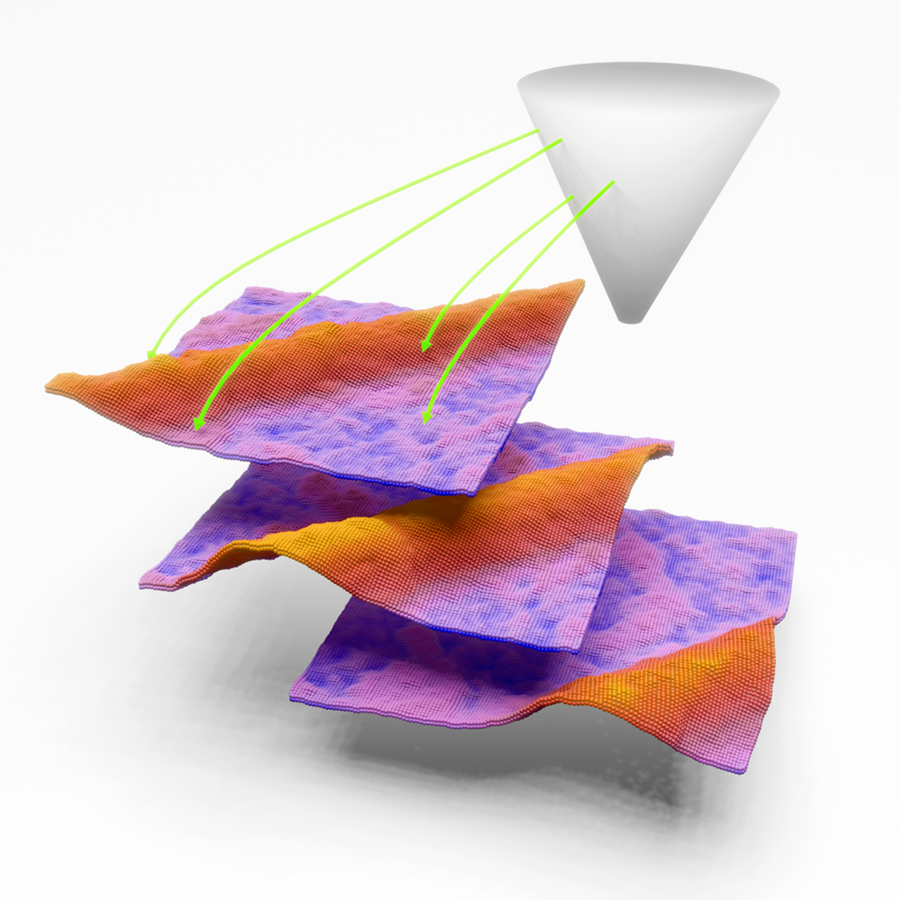Physics Team Publishes Review on Two-Dimensional Ferroelectric

Schematic illustration of a group-IV monochalcogenide monolayer interacting with a scanning tunneling microscope tip (seen as a cone). A ripple (depicted in orange) is seen to move. Tiny circles are actual atoms within the 2D ferroelectric. Image courtesy of Kai Chang/Max Planck Institute for Microstucture Physics.
U of A physicists published a review article on two-dimensional ferroelectrics in the journal Reviews of Modern Physics, a high-profile journal self-described as "the world's premier physics review journal."
Two-dimensional materials are ultrathin membranes that hold promise for novel optoelectronic, thermal and mechanical applications. "A vigorous push for the deployment of atomically-thin, two dimensional ferroelectrics has taken place over the past five years," said Salvador Barraza-Lopez, associate professor of physics and coauthor of the paper.
Barraza-Lopez and postdoctoral research associate John W. Villanova coauthored the 20-page article that reviewed a family of two-dimensional ferroelectrics known as group-IV monochalcogenides. The article, "Colloquium: Physical properties of group-IV monochalcogenide monolayers," presents a theoretical and experimental exposition of the main physical features of these materials, such as their switchable, in-plane, spontaneous polarization; soft elastic constants; structural degeneracies and thermally driven two-dimensional structural transformations. Selective valley excitations, valley Hall effects, and persistent spin helix behavior were also covered by the authors. Optical properties such as an unusually strong second-harmonic intensity, large bulk photovoltaic effects, photostriction and tunable exciton binding energies were also discussed.
In addition to Barraza-Lopez and Villanova, authors include Benjamin Fregoso of Kent State University, Stuart S. P. Parkin of the Max Planck Institute for Microstructure Physics and Kai Chang of the Beijing Academy of Quantum Information Sciences.
Work at Arkansas was funded by an Early Career Grant from the U.S. Department of Energy, Office of Basic Energy Sciences. Calculations were performed at University of Arkansas' Trestles, funded by the U.S. National Science Foundation, a grant from the Arkansas Economic Development Commission, the Office of the Vice Provost for Research and Innovation, and at Cori at NERSC, a U.S. Deparment of Energy Office of science user facility.
Topics
Contacts
Salvador Barraza-Lopez, associate professor
Department of Physics
479-575-5933,
sbarraza@uark.edu
Bob Whitby, feature writer
University Relations
479-575-4737,
whitby@uark.edu
Headlines
Four Students Named Goldwater Scholars; Two Earn Udall Honorable Mentions
Four U of A students have received the prestigious Goldwater Scholarship, an award for top students in mathematics, science, and engineering.
Cross-Campus Collaboration Culminates in New Outdoor Geological Installation
Grand opening event to celebrate the new GeoLab installation at the U of A’s Gearhart Hall courtyard is set for May 3. The installation will be open to the public year-round.
First Students to Use Online Degree to Hone Nursing Leadership, Elevate Patient Care
Hanna Baxendale and Wendi Kimbrell will begin coursework in the Doctor of Nursing Practice-Executive Master of Business Administration program offered by the Eleanor Mann School of Nursing and Walton College.
Join the Office for Sustainability on a Final Cruise to Campus
Cruise to Campus Wednesdays have fostered a gathering space for individuals interested in biking to campus. Drop by the Old Main Lawn from 7:30-10 a.m. Wednesday for coffee, something to eat and conversation.
Fay Jones School Student Ambassador Program Gives Voice to Design Students
The student ambassador program at the Fay Jones School of Architecture and Design is built to connect top design students with their school, its alumni, its future students and others inside and outside the school.




